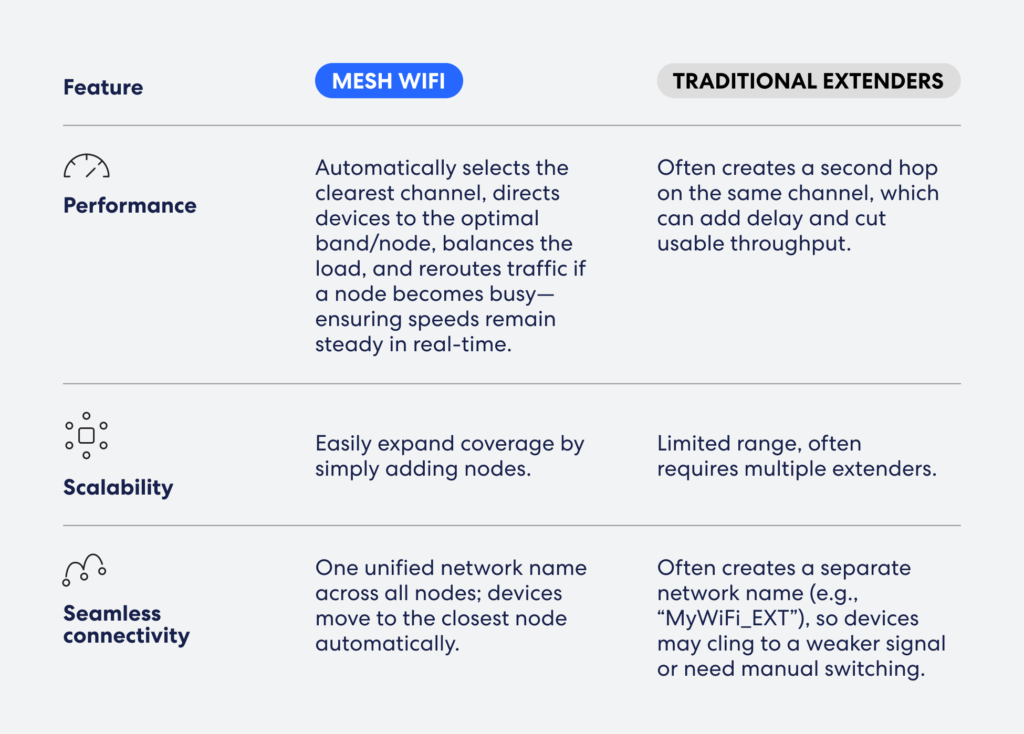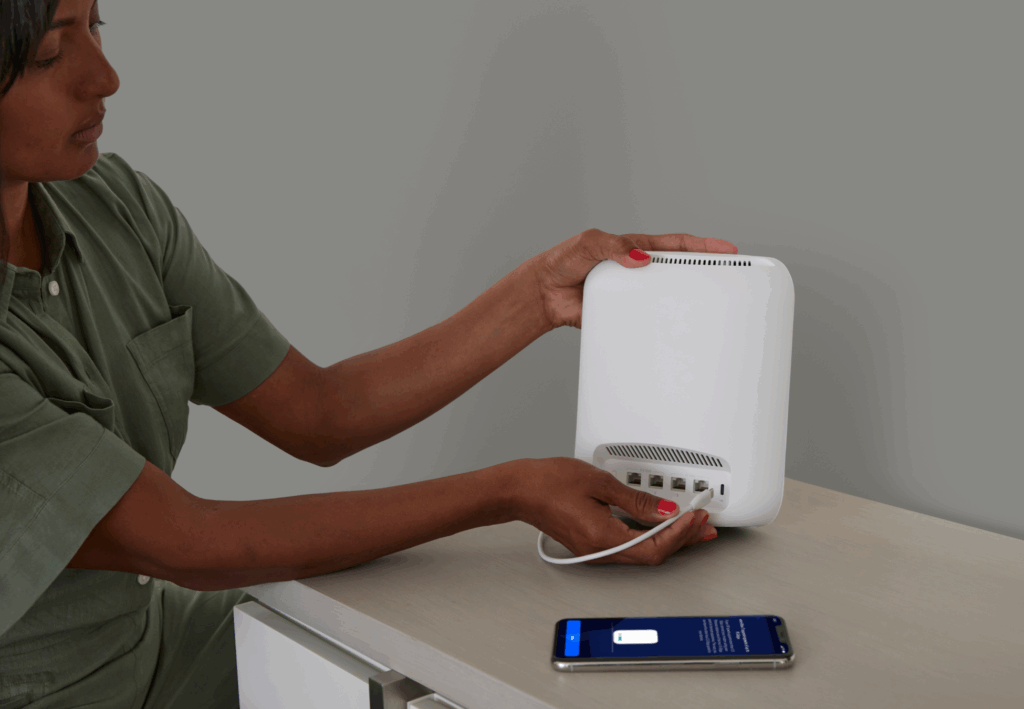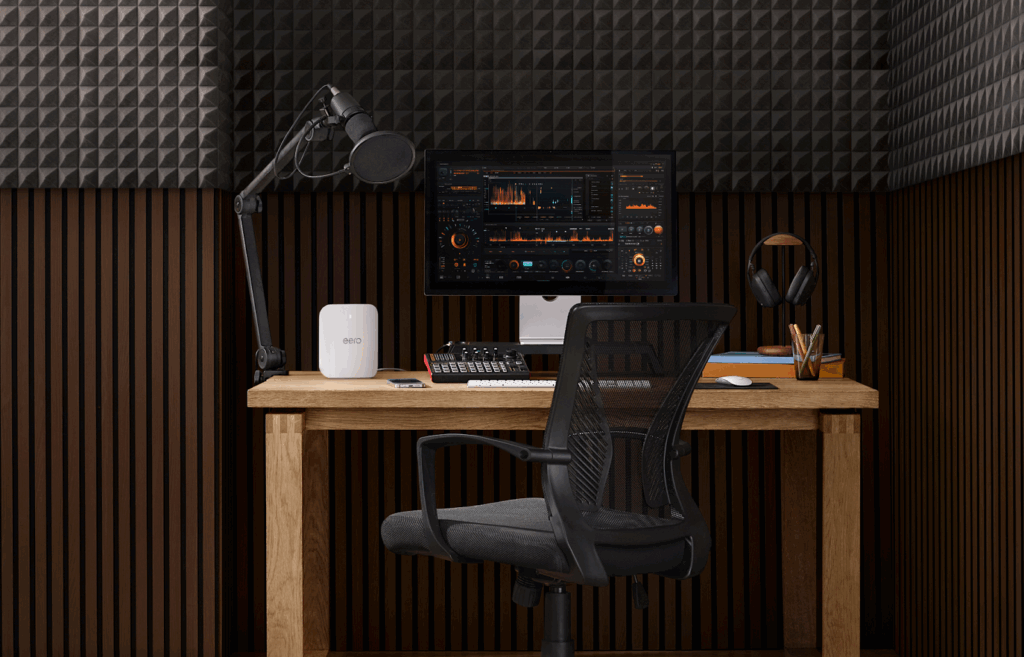
- Mesh wifi replaces a single router and extenders with one unified network that helps reduce dead zones and keeps speeds steadier as you move.
- Plan your layout and place mesh nodes in open, central spots away from obstructions for more consistent coverage.
- Use the app to set up your network, manage security and guest access, and keep firmware updated.
- Hardwire high-demand devices (like TVs, servers, and security cameras) with Ethernet to free up wireless bandwidth.
- Choose mesh gear that fits your space—eero Pro 7 for busy homes, eero PoE 7 for clean, scalable business installs—and upgrade as your speeds, device counts, and security needs grow.
How to boost wifi signal in homes and businesses

Traditional routers push all traffic from one spot. As soon as you move a few rooms or a floor away, the signal has to fight through walls, appliances, and interference. The result: buffering in the living room, lag in the office, and a dead spot near the backyard door.
Mesh wifi flips that model. Instead of one overworked router, you place a few compact nodes around your space. They talk to each other to route traffic intelligently, helping to eliminate dead zones and keeping speeds steadier where you actually use devices—on every floor and even outdoors. If you’ve been wondering how to boost your wifi signal for faster, more reliable performance, the answer is to upgrade to a mesh system.
Whether you’re working from an apartment, a multistory home, a backyard, or a business building, you may have asked yourself, “How can I boost my wifi signal for faster speeds?” You’re not alone: about two-thirds of U.S. households reported wifi issues in the past year. The answer is simple: Upgrade to a mesh system and optimize your setup.
Learn how you can boost wifi signal so you can seamlessly work, stream, create, and play online.
Understand the challenges of wifi in large buildings

To learn how to boost wifi signal strength, you first need to know what’s holding it back:
- Signal weakness in large spaces – Traditional routers try their best, but they’re like a tiny megaphone in a stadium—ineffective. They send wifi from one spot and radio signals weaken with distance. This is a key difference when comparing mesh vs single router setups.
- Network congestion – Wifi is a shared medium: Each radio can communicate with only one device at a time on a channel, so dozens of devices (plus nearby networks) compete for the same airtime. As contention rises, the router slows transmissions to accommodate distant or busy clients, which means everyone feels the slowdown.
- Dead zones and interference – Building materials like metal, brick, and thick floors absorb or reflect radio signals, creating spots where the router’s signal can’t reliably reach. Appliances and gadgets that emit on similar frequencies (e.g., microwaves, baby monitors) add noise, forcing retries and dropped connections.
In contrast, mesh wifi systems pick up where traditional routers drop off, keeping your connection strong, reliable, and far-reaching.
What is a mesh wifi system?
A traditional setup is hub-and-spoke: One router in the middle routes everything, which can become a bottleneck as distance and devices grow. A mesh system is many-to-many: Several nodes share the load and hand off traffic, so devices connect to the nearest node for steadier coverage throughout your space.
Mesh wifi vs. traditional extenders: What’s the difference?
Some homeowners, renters, and businesses try to fix weak signals with traditional wifi extenders, but these aren’t the best long-term solution. Here’s how they compare to mesh systems.
Unlike range extenders, wifi extender vs mesh comparisons highlight a major flaw in traditional extenders—while extenders create separate networks that require manual switching, mesh wifi operates as one unified system.
Mesh systems also self-optimize in real time, dynamically adjusting to interference and bandwidth demands. That means fewer disruptions and more time for work, streaming, or gaming. Modern mesh systems also integrate machine learning to detect peak usage hours and automatically adjust performance for optimal efficiency.
If your home or business relies on fast, reliable internet, mesh wifi is a better choice.

Benefits of using mesh wifi to extend your wifi signal
Mesh wifi isn’t just an upgrade—it’s a game-changer for connectivity. A high-quality mesh system can:
- Help eliminate dead zones – Mesh places multiple nodes around your space, so devices connect to a nearby node instead of stretching to one distant router. Shorter hops fill coverage gaps and keep the signal strong as you move.
- Offer seamless roaming – Mesh lets devices hand off to the nearest node with no manual steps. eero’s TrueRoam helps guide devices to the best eero for their location, improving stability as you move from room to room.
- Support more devices – Mesh spreads devices across multiple nearby nodes and bands, so each node serves a smaller crowd, reducing airtime contention. Laptops, smartphones, smart TVs, printers—mesh wifi keeps them all running smoothly.
- Facilitate easy network management – Most systems come with a companion app for setup and visibility. With the eero app, you can set up in minutes, see every connected device, pause wifi, share a guest network, run speed tests, get outage/issue alerts, and manage your network remotely.
For those looking for faster connectivity speed, the eero PoE 7 is an excellent option, offering wired-like speeds with Power over Ethernet (PoE) technology.
Setting up mesh wifi
Setting up mesh wifi isn’t complicated. Follow these steps to ensure smooth, reliable coverage throughout your space.

1. Assess the building layout
- Identify weak spots where wifi disappears.
- Note thick walls and high-traffic areas.
- Decide where critical devices (e.g., servers, smart tech) are located.

2. Choose the right mesh system
- Reliable models offer enhanced security and bandwidth. Learn what makes eero stand out in the mesh wifi space.
- If you’re running a business, opt for devices that support scalability, allowing your system to grow with your business.

- Place nodes in central, elevated spots.
- Keep them away from large metal objects and microwaves.
- Space them evenly to help eliminate weak zones.

- Use the mesh system’s app to configure your network.
- Set up guest networks and security features.
- If the app doesn’t already have automatic firmware updates like the eero app, you should regularly update firmware to keep everything running smoothly.
Additional tips to maximize wifi performance
While the instructions above will set you up for mesh success, you can optimize your system by following a few best practices. Keep your mesh wifi running at peak performance with these simple tricks:
- Reduce interference – Keep nodes away from electronics that emit competing signals (e.g., cordless phones, baby monitors).
- Regular maintenance – Manufacturers roll out updates to improve security and speed—stay on top of them. eero applies updates automatically with no manual maintenance required.
- Use Ethernet for high-demand devices – Plug stationary, high-demand devices such as servers, security cameras, and streaming devices directly into an Ethernet port. A wired connection gives them a dedicated, interference-free path with steadier speeds and lower latency.
- Automatic bandwidth management – Many modern mesh systems manage bandwidth and airtime in the background to keep time-sensitive apps (like video calls) responsive. The eero app handles this in the background automatically—no manual priority rules needed.
- Monitor performance – Most mesh systems offer basic network visibility (connected devices, link quality, speed tests) so you can spot issues quickly. The eero app provides these views in real time.
- Leverage AI optimizations – Some modern mesh systems use AI to detect usage trends and automatically adjust settings for optimal performance.
- Enable enhanced security measures – Protect sensitive data with firewall configurations, VPN access, and multifactor authentication.
Common wifi mistakes (and how to fix them)

Even with a solid setup, small mistakes can weaken your network. Avoid these common pitfalls:
- Overloading a single router – Traditional routers struggle with high device loads. Solution: Upgrade to a mesh wifi system.
- Poor node placement – Hiding routers in closets or placing them near metal objects weakens signals. Solution: Keep nodes in open, elevated areas.
- Ignoring firmware updates – Outdated software leads to security risks and performance issues. Solution: Enable automatic updates.
- Using outdated hardware – Older routers and modems can bottleneck speeds. Solution: Invest in Wi-Fi 7-enabled mesh systems.
Fixing these mistakes ensures smoother connectivity and fewer network headaches.
When to upgrade your mesh wifi system

Even the best mesh networks need periodic upgrades. Watch for these signs:
- Frequent slowdowns – If speeds drop despite troubleshooting, your system may be outdated.
- Increased device load – More smart devices and IoT integrations demand stronger performance.
- Security vulnerabilities – Older systems may lack critical security updates and encryption protocols.
- Limited compatibility – If your mesh system can’t support the latest wifi standard, it’s time to upgrade.
Regularly assessing your wifi setup keeps you ahead of connectivity challenges.
Upgrade your wifi with eero
A fast, reliable network is essential for modern connectivity. If you’re still wondering how to boost wifi signal in your home or workplace, the answer is clear—mesh wifi is your best bet.
With a mesh wifi system, you can say goodbye to dead zones, improve speed, and manage your network effortlessly. No more buffering. No more dropped calls. Just fast, reliable coverage and connectivity.
Not sure which mesh system to consider? Start with eero.
From small apartments to multistory homes and busy offices, there’s an eero Wi-Fi 7 option for every internet need:
- eero Max 7 — Our most capable system for large spaces, multi-gig service, and heavy smart-home use.
- eero Pro 7 — A great all-around pick for most homes; fast Wi-Fi 7 with simple expandability.
- eero 7 — An easy entry into Wi-Fi 7 for smaller homes and apartments; reliable performance with room to grow.
- eero PoE 7 — A ceiling or wall-mount Wi-Fi 7 node powered by Ethernet, ideal for pro installs and clean aesthetics.
Ready to upgrade? Compare the full Wi-Fi 7 lineup and choose the eero that fits your space today.

Sources:
Telecompetitor. Wi-Fi Connectivity Problems Persist for Two-Thirds of Americans: Survey.
EMACS. WiFi Signal Strength Degradation Over Different Building Materials.
Media of Computer Science. Wi-Fi Optimization with Wireless Mesh Networks.
Sensors. Fundamental Concepts and Evolution of Wi-Fi User Localization.

You must be logged in to post a comment.